Sometimes I struggle to choose the right flowers for my garden, especially ones that start with S. I want my garden to be beautiful and vibrant, but I’m not sure which flowers will work best.
To solve this, I’ve started researching and asking experts for advice on flowers that start with the letter S. I’ve discovered options like the Sunflower, with its bright petals, and the Snapdragon, known for its tall spikes of flowers. These solutions help me make informed choices and create a stunning garden filled with amazing flowers.
Additionally, I’ve found that incorporating flowers like the Sweet Pea, famous for its sweet fragrance, and the Shasta Daisy, which adds a touch of classic charm, can also enhance the aura of my garden.
Exploring various shades and shapes of flowers starting with S, such as the Scarlet Beebalm and the Snowdrop, has brought a sense of excitement to my gardening journey. With each new addition, my garden transforms into a delightful haven of colorful surprises.
Here are some of the best flowers that start with the letter S:
36 Flowers That Start With S
1. Sunflower – A symbol of warmth and positivity

Sunflowers are iconic blooms known for their impressive size and vibrant yellow petals. These cheerful flowers are often associated with feelings of happiness, warmth, and positivity. Helianthus annuus, their botanical name, reflects their unique characteristic of turning to face the sun throughout the day. The large, golden-yellow petals surround a central disc filled with tiny florets, creating a captivating appearance.
Sunflowers hold cultural significance in various cultures, symbolizing adoration, loyalty, and longevity. They are also used to represent the sun itself and its life-giving energy. These versatile flowers are not only admired in gardens but are also cultivated for their nutritious seeds, which are enjoyed as snacks or used to produce sunflower oil. Whether standing tall in a field or brightening up a garden, sunflowers never fail to evoke a sense of joy and positivity.
2. Sweet Pea – Delicate blossoms with a fragrant allure
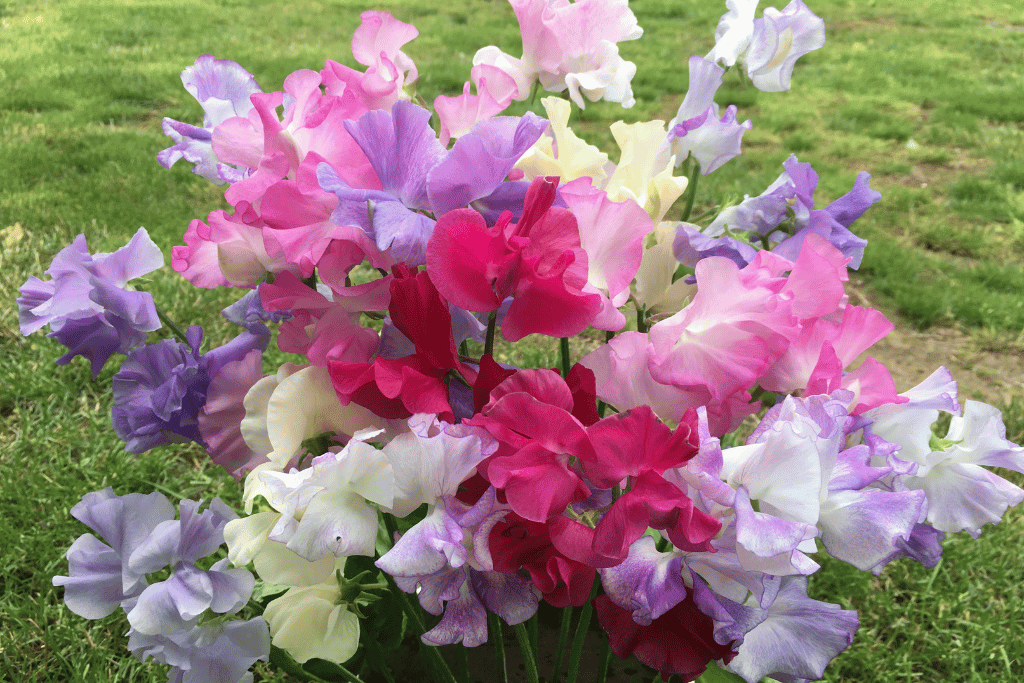
Sweet Peas, scientifically known as Lathyrus odoratus, are renowned for their delicate beauty and enchanting fragrance. These climbing annual plants produce clusters of ruffled flowers in a variety of soft pastel shades, including pink, lavender, blue, and white. Their petals are often adorned with intricate patterns that add to their charm.
These romantic flowers are not only visually pleasing but also have cultural significance, symbolizing blissful pleasure and tender memories. Sweet Peas have long been associated with sentiments of appreciation and gratitude, making them a popular choice for bouquets and floral arrangements. The blooms emit a sweet, nostalgic scent that evokes memories of gardens in full bloom.
3. Snapdragon – Graceful spikes of vibrant hues

Snapdragons have a playful quality, as their flowers can be gently squeezed to open and close their “dragon mouths.” This interactive aspect has made them a favorite among children and garden enthusiasts alike. In the language of flowers, snapdragons often symbolize graciousness and strength. Their charming appearance and versatile color palette make them a delightful addition to both formal and informal garden settings.
Scientifically referred to as Antirrhinum majus, are known for their unique shape and vibrant, tubular flowers that resemble dragon mouths. These perennial plants come in a wide range of colors, including red, yellow, pink, orange, and white. The blossoms are arranged along tall spikes, creating a vertical element that adds visual interest to gardens and flower arrangements.
4. Spider Lily – Exotic elegance in white and green
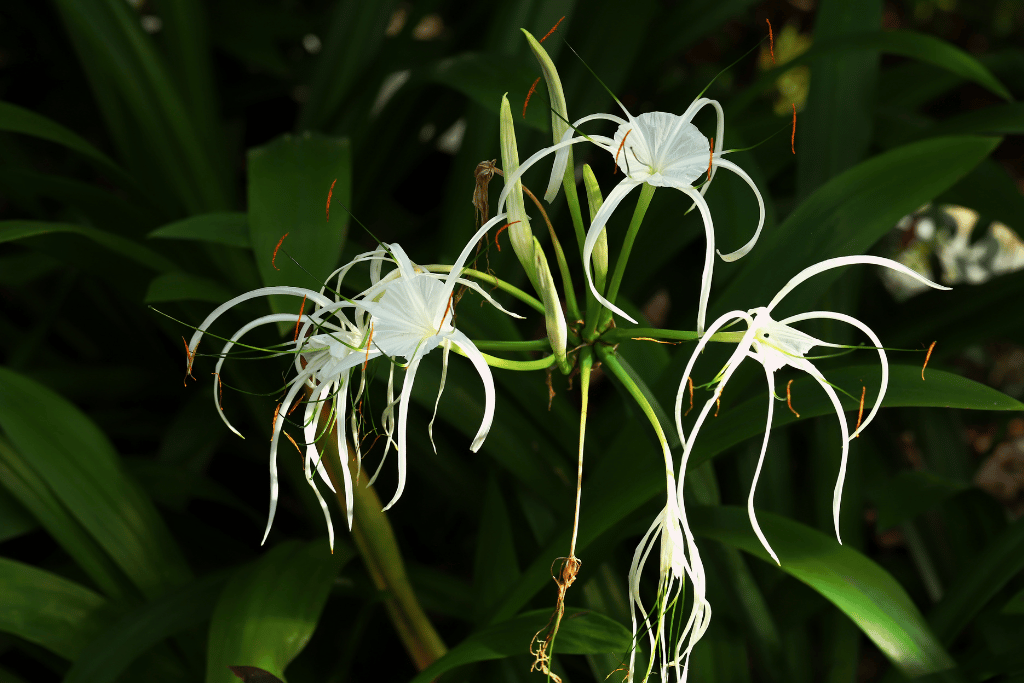
Spider Lilies flowers are visually striking and hold cultural significance in various cultures, symbolizing purity, beauty, and resilience. In scientific language, these flowers, known as Hymenocallis, are captivating flowers with a distinct and intricate appearance. Their petals are elongated and often have a spiderweb-like texture, which contributes to their common name. These white or greenish-white blooms are known for their exotic elegance and unique shape.
Spider Lilies are native to warm climates and are often found in tropical and subtropical regions. They are associated with themes of rebirth and renewal, making them a popular choice for gardens and floral displays during transitional seasons.
5. Snowdrop – A herald of spring’s arrival

Snowdrops, or Galanthus, are delicate and enchanting flowers that often appear as the first signs of spring, pushing through the snow-covered ground to announce the end of winter’s grip. These small, nodding flowers typically feature white petals with a distinctive green mark at their tips. Snowdrops have a serene and elegant presence, embodying hope and renewal.
These early-blooming flowers are cherished for their ability to bring a sense of anticipation and optimism after the cold winter months. Their subtle beauty and significance make them a cherished addition to gardens and landscapes, symbolizing the awakening of nature’s beauty after a period of dormancy. Snowdrops have inspired various legends and folklore, often associated with purity, hope, and the promise of new beginnings.
6. Stephanotis – Elegance and tradition in white blooms
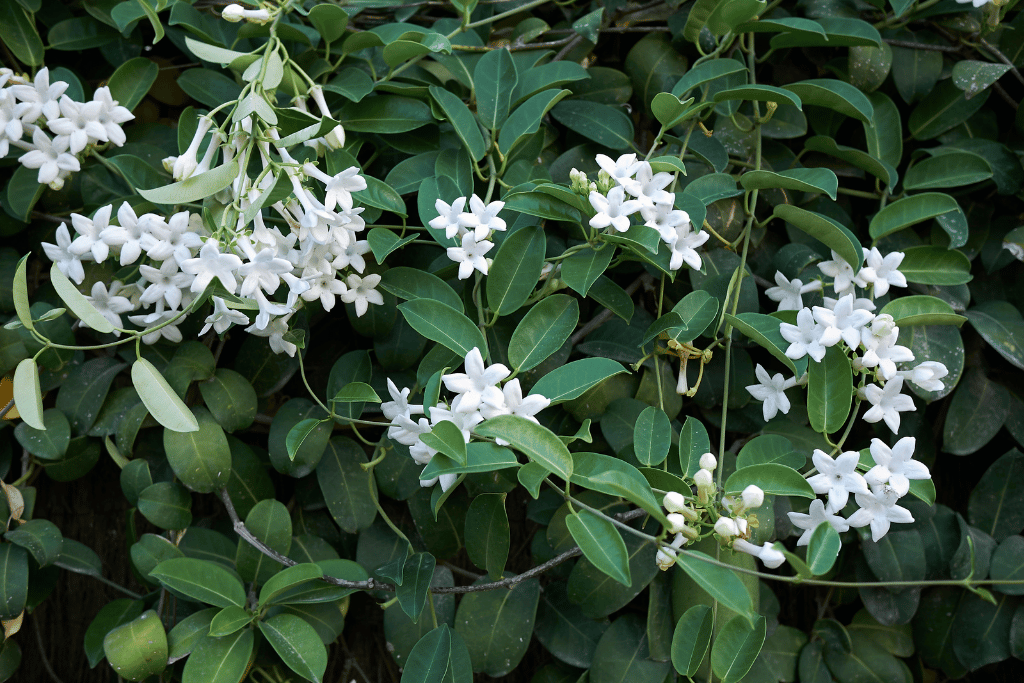
Native to Madagascar and other tropical regions, the Stephanotis vine’s lush foliage and exquisite blooms make it a popular choice for adorning trellises and arbors in gardens. The vine’s delicate blossoms and timeless appeal have contributed to its reputation as a symbol of love, commitment, and devotion. The vine produces clusters of waxy, fragrant flowers that symbolize marital happiness and the bond between partners.
Stephanotis, scientifically known as Stephanotis floribunda, is a vine renowned for its elegant, star-shaped white flowers and rich, sweet scent. Often called the “bridal veil” or “Madagascar jasmine,” these blossoms are frequently used in wedding bouquets and floral arrangements.
7. Stock – Fragrant clusters of blossoms
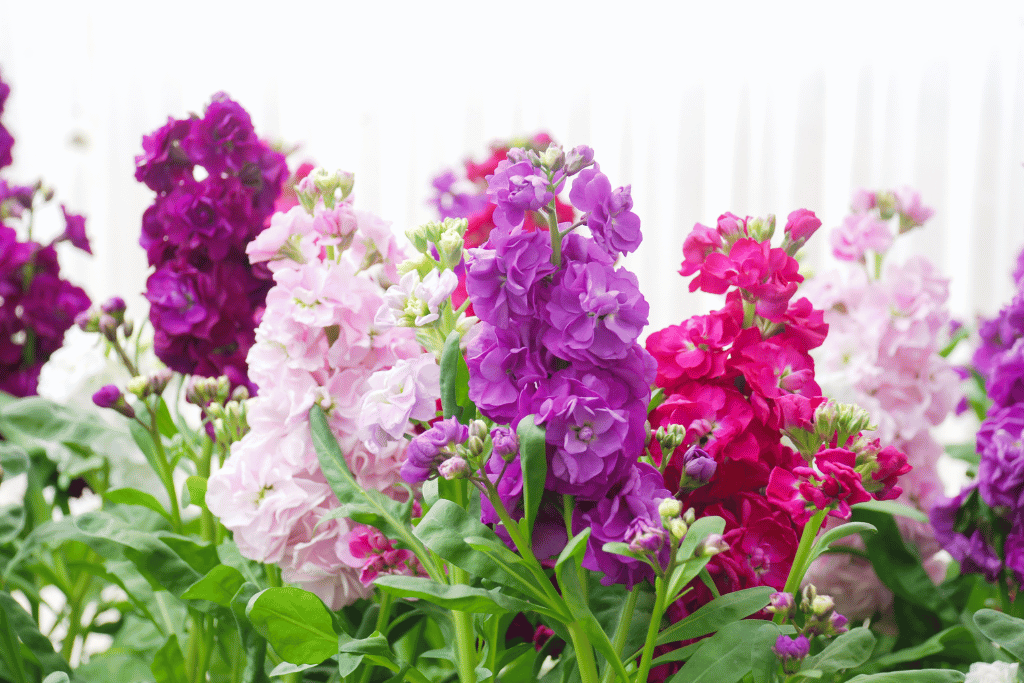
Stock flowers have a sweet and spicy scent that intensifies in the evenings, attracting pollinators like moths. These blooms come in a range of colors, including pink, purple, white, and pastel shades. Scientifically known as Matthiola incana, is a flowering plant prized for its captivating fragrance and densely clustered flowers.
The stock flower has a long history of use in perfumery and ornamental gardening. Its lush, densely packed blossoms create a visual spectacle that enhances garden landscapes. Often associated with beauty and lasting affection, stock flowers are exchanged as meaningful gifts to express deep emotions and fondness.
8. Salvia – A diverse genus of vibrant blooms
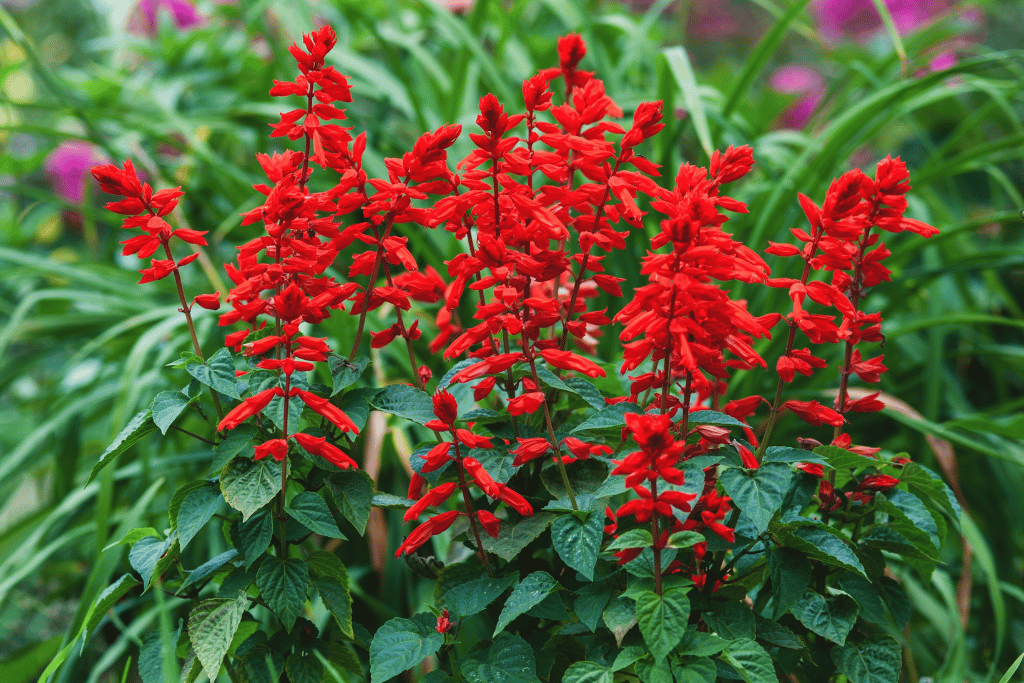
With over 900 species, Salvia offers a wide array of options for gardeners seeking vibrant and long-lasting blooms. It is a diverse genus of flowering plants known for their striking spikes of tubular flowers in various colors, including blue, purple, red, and pink. These flowers are well-loved for their pollinator-attracting qualities and adaptability to different climates.
The cultural symbolism of Salvia varies across cultures, often associated with virtues like wisdom, healing, and protection. The common name “sage” is shared with some species of Salvia, connecting these plants to spiritual and medicinal significance. Whether adorning gardens, attracting beneficial insects, or holding cultural value, Salvia species bring beauty and diversity to landscapes around the world.
9. Starflower – Delicate and enchanting wildflowers
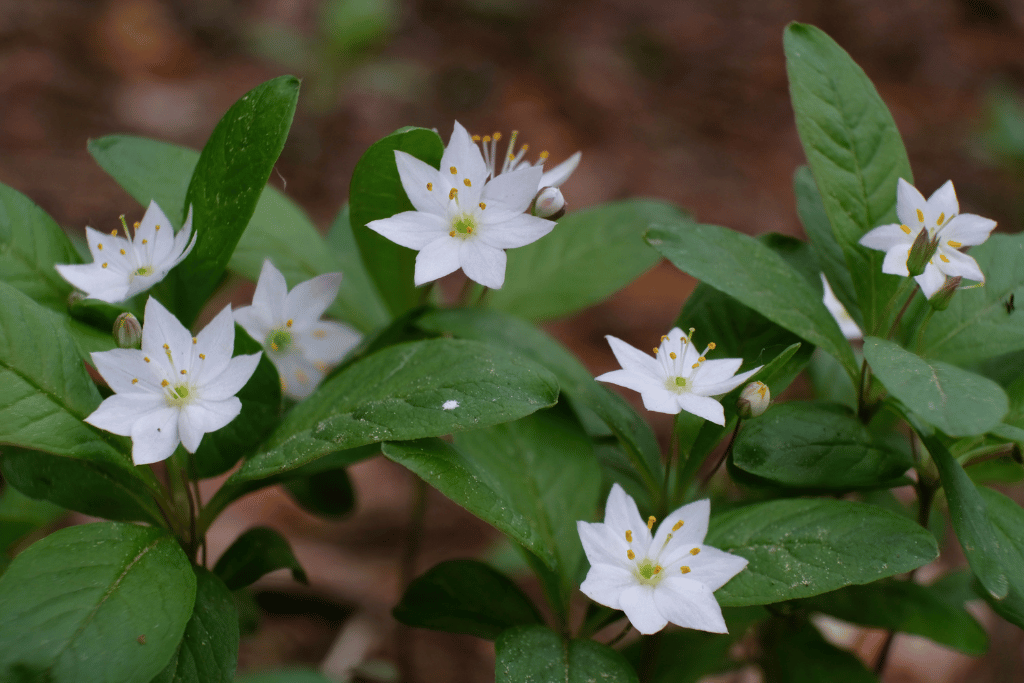
Starflowers, belonging to the genus Trientalis, are delicate wildflowers with a captivating charm. These dainty blossoms typically have five to nine white or pink petals arranged in a star-like shape, hence their common name. Starflowers are often found in woodland settings, adding a touch of enchantment to shaded areas.
These small, elegant blooms evoke a sense of wonder and tranquility, making them a popular choice for nature enthusiasts and gardeners who appreciate the beauty of native plants. In various cultures, starflowers symbolize different qualities, including purity, simplicity, and connection to nature. Their unassuming elegance and understated beauty contribute to their allure in natural landscapes and cultivated gardens.
10. Statice – A burst of color and texture
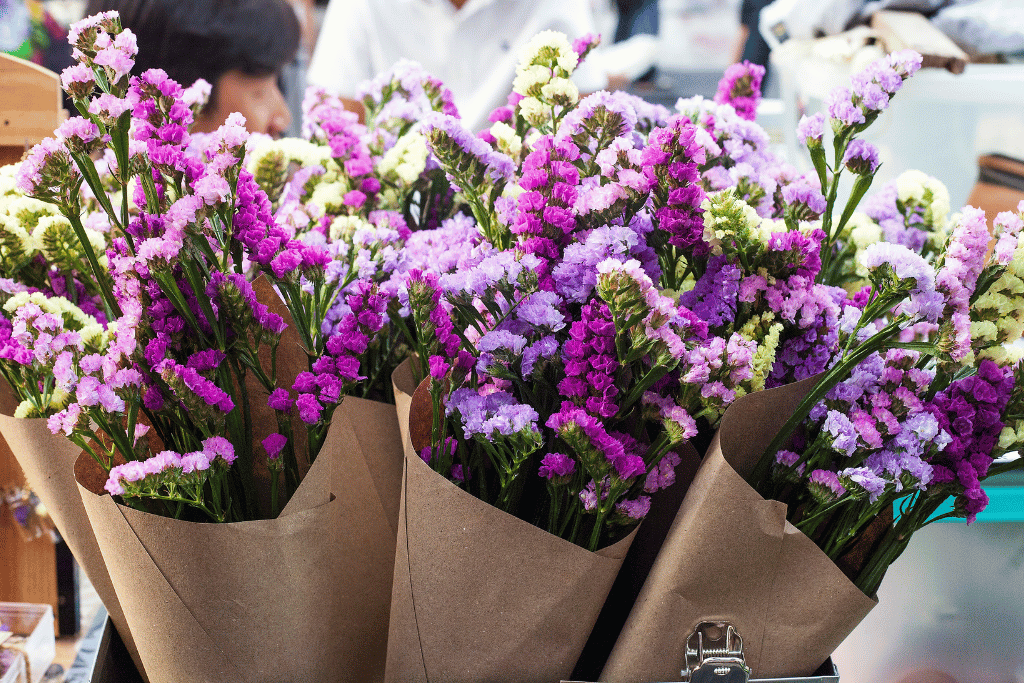
Statice blooms come in shades of blue, purple, pink, white, and yellow. The enduring nature of statice flowers has led to associations with long-lasting memories, fidelity, and remembrance. Their versatility and ability to add visual interest to various floral compositions make them cherished components of bouquets and crafts. Whether adorning a vase or being preserved as a memento, statice flowers bring color and texture to arrangements that span from the ephemeral to the enduring.
Botanically known as Limonium, is a genus of flowering plants celebrated for their vibrant and papery blooms that retain their color even when dried. These flowers are often used in both fresh and dried floral arrangements, providing texture, contrast, and lasting beauty.
11. Sword Lily – Majestic spikes of vibrant hues

Sword Lily, majestic flowers bring vertical drama and a splash of color to landscapes, earning them a place among popular choices for both home gardens and professional floral design. These blooms come in a wide array of colors, including red, pink, orange, yellow, and white, each with its own symbolic meaning. The sword-like shape of its leaves gives the plant its common name.
Scientifically known as Gladiolus, is a striking flowering plant known for its tall spikes adorned with multiple blossoms. The Sword Lily is associated with various meanings such as strength, honor, and infatuation. Its impressive height and vibrant blooms make it a favorite in garden beds, borders, and cut flower arrangements. These
12. Saffron Crocus – Precious spice and delicate beauty
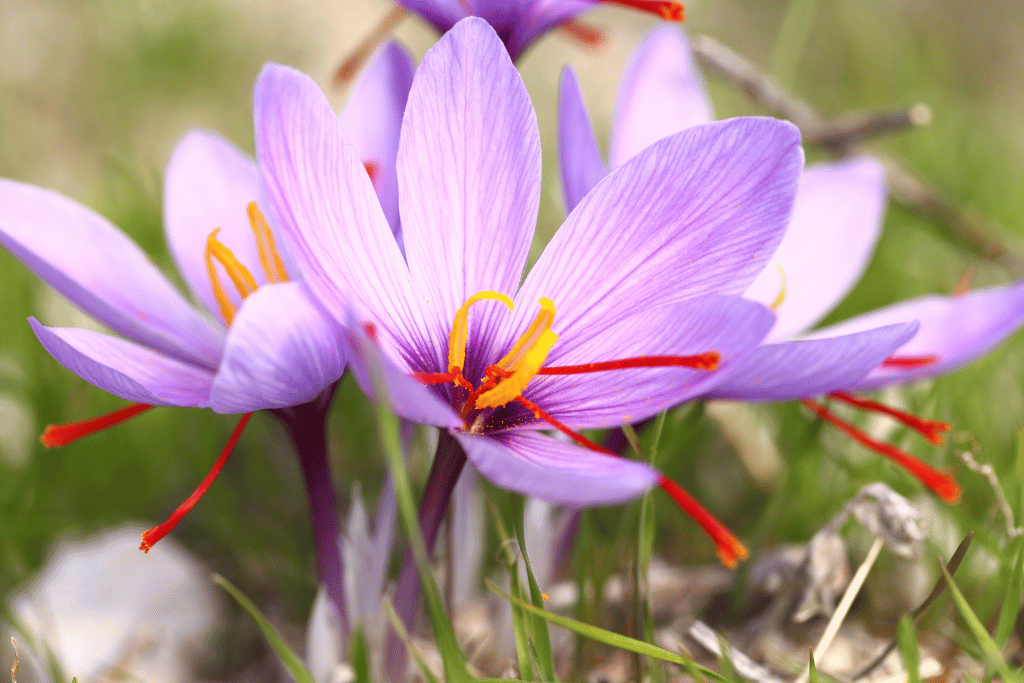
Saffron Crocus, or Crocus sativus, is a small but significant flowering plant known for producing saffron, one of the world’s most expensive spices. The vibrant purple blooms feature three red stigmas, which are carefully harvested and dried to create saffron threads. Aside from its culinary use, saffron crocus boasts delicate beauty with its lavender petals and fiery-red stigmas.
Native to Southwest Asia, saffron crocus holds cultural and historical significance in various cuisines and traditional medicines. It represents luxury, vitality, and wisdom in different cultures. Cultivating saffron requires special care due to its specific growth requirements, making it a prized addition to gardens and farms that appreciate its dual value of both spice and beauty.
13. Shooting Star – Ethereal wildflowers of woodland realms
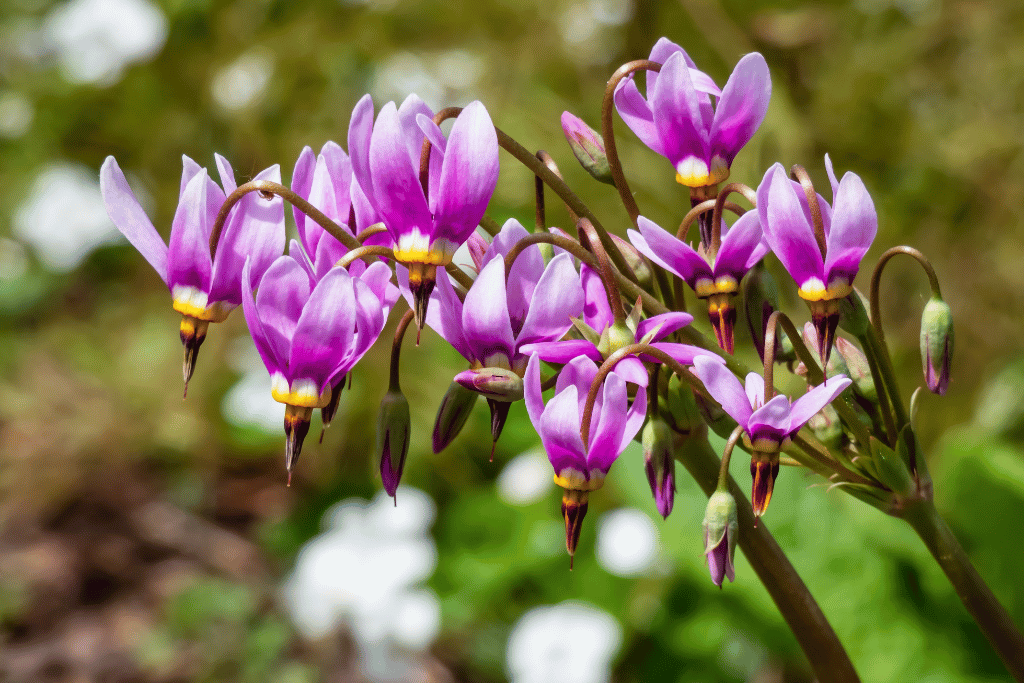
Shooting Stars are native wildflowers are cherished for their ephemeral beauty and role in local ecosystems, often attracting pollinators like butterflies and bees. Their appearance heralds the arrival of spring and the awakening of nature’s splendor, making them a cherished sight for those who venture into woodland habitats. These delicate blooms resemble downward-facing stars, with petals curving back like shooting rays. They are typically shades of pink or white and often have unique patterns and markings on their petals.
These pink color flowers hold cultural and symbolic significance as symbols of renewal, transformation, and connection to the spiritual world. Shooting Star, scientifically known as Dodecatheon, is a group of wildflowers that grace woodland areas with their ethereal beauty.
14. Spider Orchid – Intricate blooms with a touch of drama
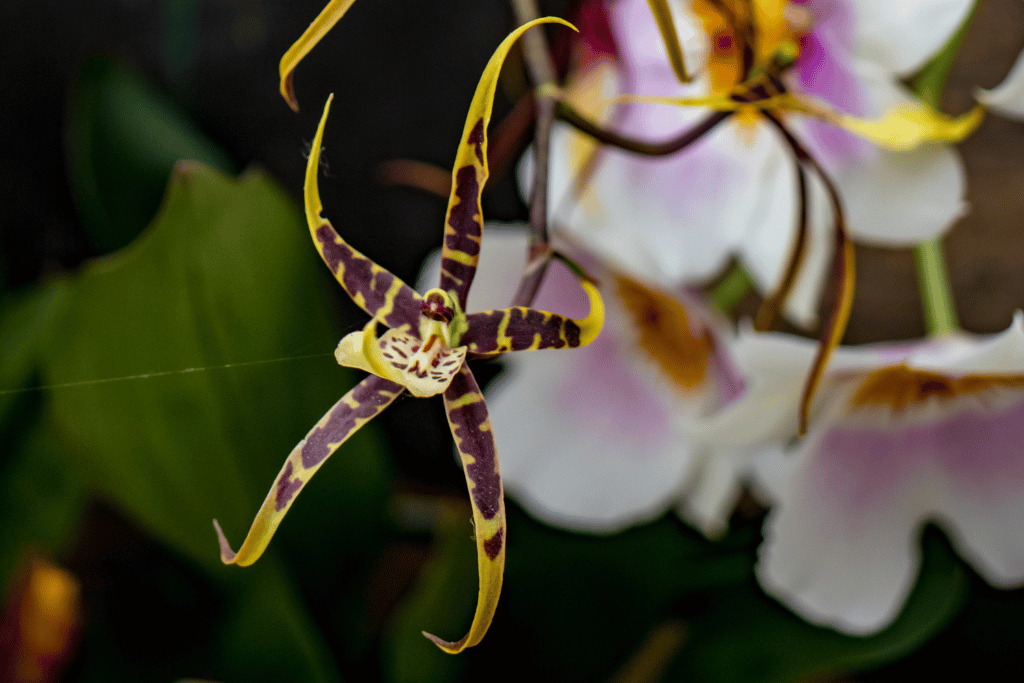
Spider Orchid, belonging to the genus Brassia, is known for its captivating and intricate flowers that resemble the appearance of a spider. These unique blooms have elongated petals and sepals, often with intricate patterns and designs that mimic the appearance of a spider’s legs. Spider orchids come in a variety of colors and shapes, each with its own unique charm.
Native to tropical regions of the Americas, spider orchids are celebrated for their exotic beauty and unusual form. They are often prized by orchid enthusiasts and collectors for their intriguing appearance. While their visual likeness to spiders might be unsettling to some, these orchids stand out as prime examples of nature’s remarkable diversity and adaptability.
15. Sea Lavender – Coastal elegance in purple-blue clusters
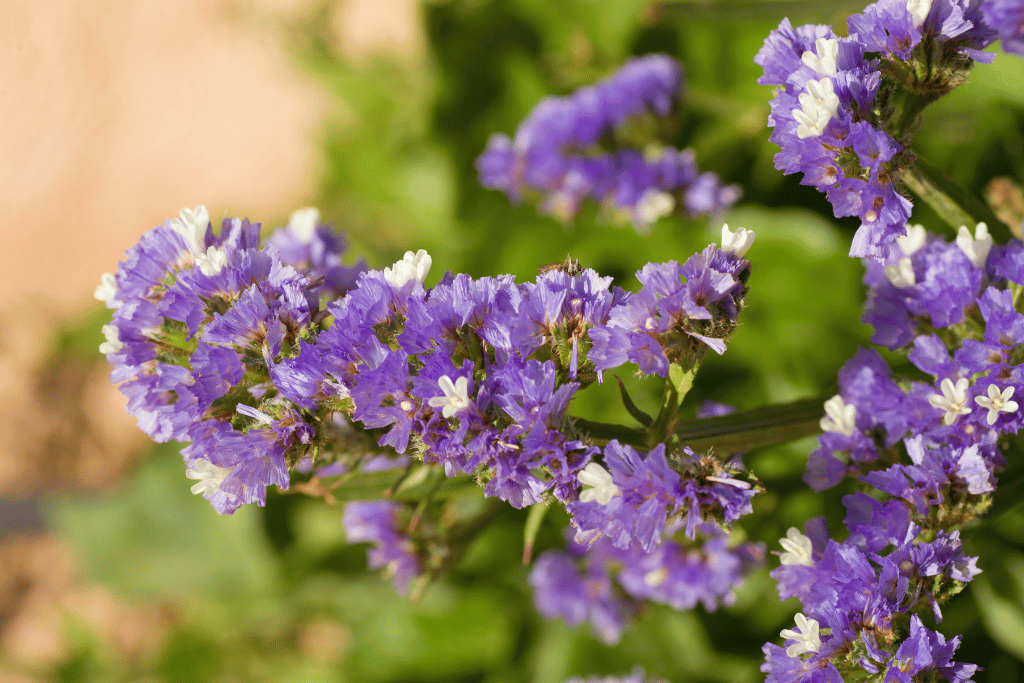
Sea Lavender, scientifically known as Limonium sinuatum, is a coastal flowering plant that graces sand dunes and seaside landscapes with its clusters of tiny, papery flowers. Despite its name, sea lavender is not related to true lavender but rather belongs to the plumbago family. Its blooms range from shades of purple to blue and pink, creating a soft and calming palette.
Sea Lavender’s ability to thrive in saline environments has led to its association with resilience and adaptability. The plant is often used in dried flower arrangements due to its ability to retain color and shape even after drying. Its delicate clusters of blossoms contribute to the serene and elegant atmosphere of coastal habitats, making it a favorite among those who appreciate the beauty of maritime landscapes.
16. Shasta Daisy – Timeless beauty in white petals
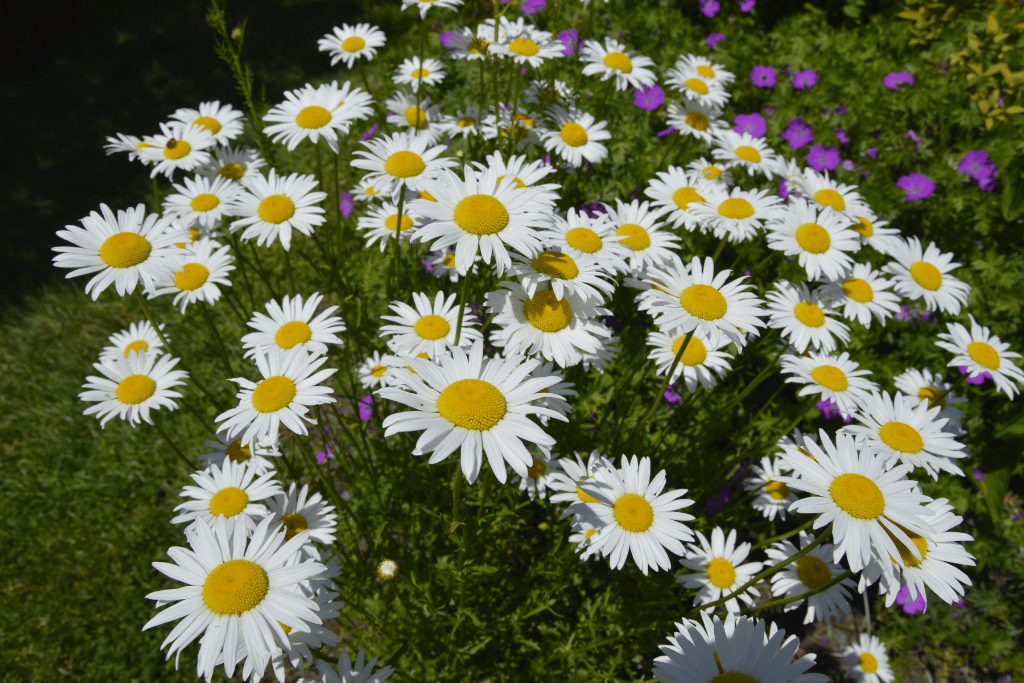
Shasta daisies come in various sizes and varieties, offering options for gardeners seeking to add a touch of elegance to their landscapes. Named after Mount Shasta in California, these daisies have become popular symbols of innocence, purity, and new beginnings. Their cheerful and uncomplicated appearance makes them a staple in cottage gardens, borders, and cut flower arrangements.
Scientifically known as Leucanthemum x superbum, is a classic perennial flower recognized for its timeless white blooms with bright yellow centers. These flowers are known for their simple yet charming appearance, reminiscent of sunny meadows. Shasta daisies’ ability to thrive in a variety of climates and settings has cemented their status as beloved garden favorites.
17. Sundew – Carnivorous beauty of wetlands
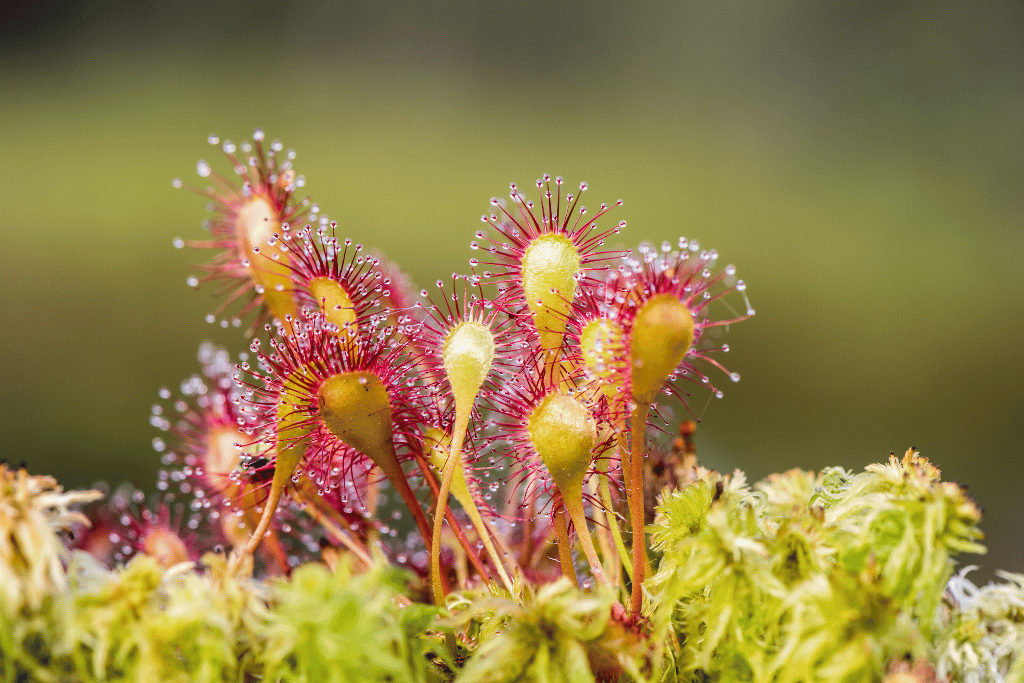
Sundew, belonging to the genus Drosera, is a group of carnivorous plants known for their unique and captivating method of capturing prey. These plants have sticky glandular hairs on their leaves that attract, trap, and digest insects, serving as a source of nutrients in nutrient-poor environments. Sundew flowers are typically small and range in color from white to shades of pink.
Sundews can be found in various wetland habitats around the world, such as bogs and marshes. Their carnivorous nature and ability to adapt to challenging conditions have made them subjects of fascination for botanists and nature enthusiasts. Sundews serve as a reminder of the intricacies of nature and the remarkable ways in which plants have evolved to survive in diverse ecosystems.
18. Snowbell Tree – Graceful clusters of bell-shaped blooms
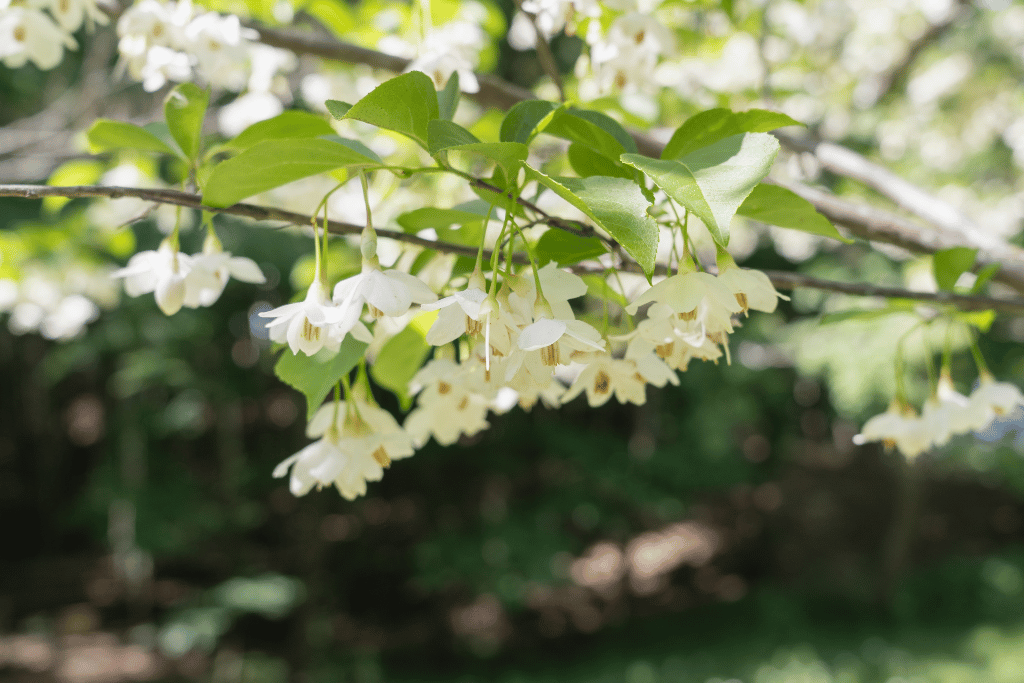
Native to East Asia and North America, Snowbell Trees are appreciated for their elegant appearance and ability to bring a touch of grace to outdoor spaces. The delicate appearance of the bell-shaped flowers and their light fragrance contribute to a serene and tranquil atmosphere. Snowbell Trees symbolize qualities like grace, elegance, and purity, making them a favored choice among those seeking to add a touch of sophistication to their garden designs.
In scientific language, Snowbell Tree is known as Styrax. It is a small tree known for its graceful clusters of bell-shaped white or pale pink flowers that hang delicately from the branches. These flowers emit a gentle fragrance that adds to their charm and allure. Snowbell trees are often used as ornamental specimens in gardens, particularly in Asian-inspired or woodland landscapes.
19. Sneezeweed – Burst of color in late summer
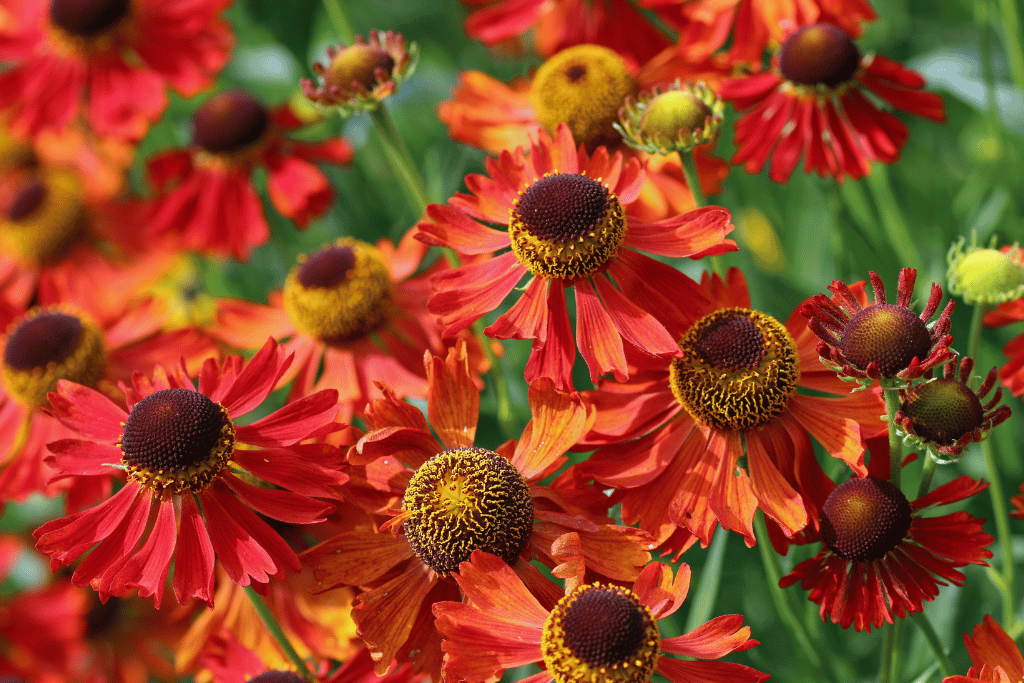
Sneezeweed’s playful common name is derived from the historical use of its dried leaves as a component of snuff. Botanically named Helenium is a genus of flowering plants that brightens late summer and early fall landscapes with its vibrant blooms. These daisy-like flowers come in shades of yellow, orange, and red and often have distinctive dark centers.
These bold and cheerful flowers symbolize joy, abundance, and endurance, adding a burst of color to gardens and natural areas as summer transitions into autumn. Native to North and Central America, sneezeweed species are valued for their ability to attract pollinators like bees and butterflies during a season when nectar sources can be limited. Despite its name, sneezeweed’s pollen is not a source of irritation for humans.
20. Sea Pink – Hardy coastal blooms
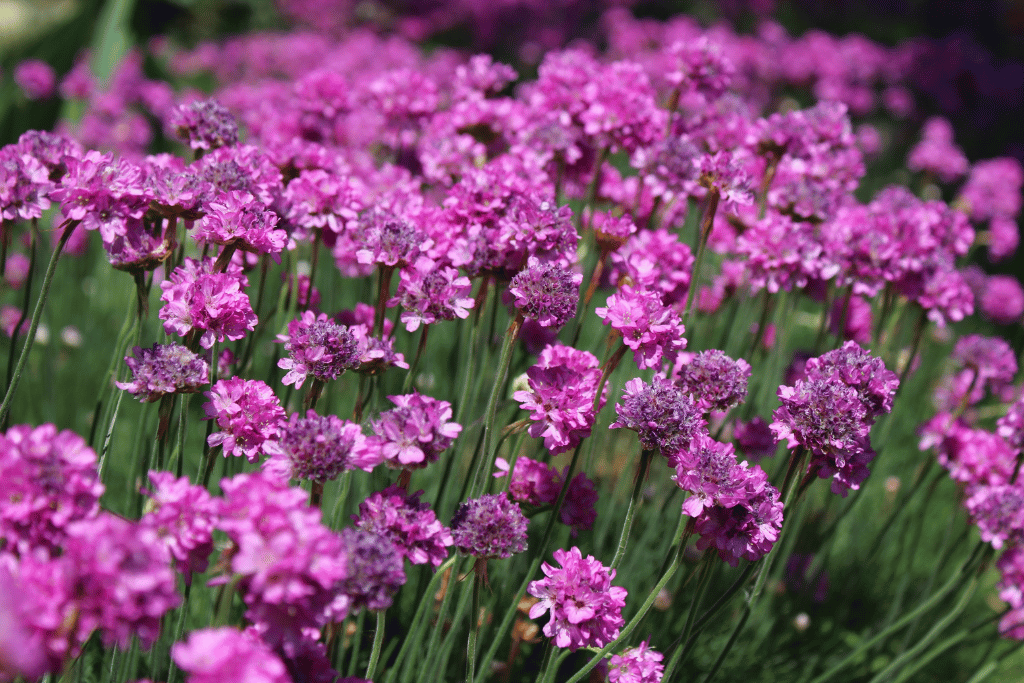
Sea Pink, commonly known as thrift or cliff rose, displays spherical bunches of small pink or white flowers on elongated, slim stalks. Scientifically labeled as Armeria maritima, this resilient and delightful flowering plant prospers within coastal environments. Its capacity to endure demanding coastal conditions enhances its worth as a valuable inclusion in seaside gardens.
The flowers’ pastel hues and resilience reflect qualities of endurance, strength, and beauty even in challenging circumstances. Whether planted in rock garden or coastal landscapes, sea pink embodies the rugged yet delicate nature of coastal ecosystems. Native to Europe, sea pink is admired for its hardiness and adaptability. It’s often used in coastal landscaping to stabilize soil on cliffs and dunes while adding a pop of color to the environment.
21. Star of Bethlehem – Graceful blooms of spring
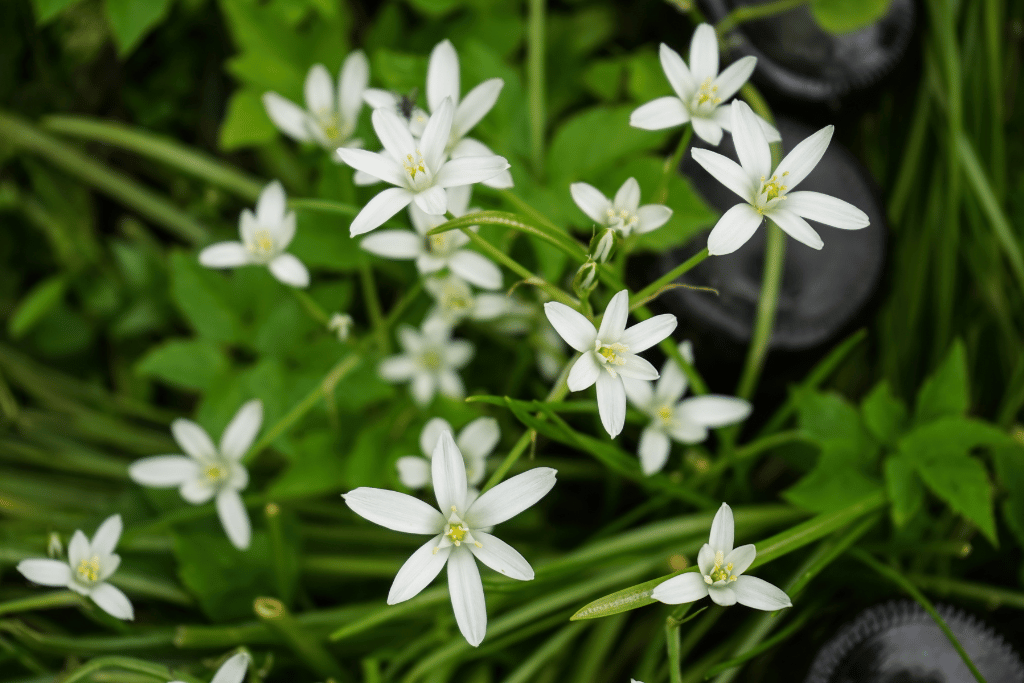
Star of Bethlehem is appreciated for its ornamental value and its ability to create a charming display in gardens and meadows during the spring months. The name “Star of Bethlehem” is a reference to the biblical story of the star that guided the Wise Men to the birthplace of Jesus. These flowers often grow in clusters and emerge in early spring, contributing to the season’s sense of renewal and awakening.
Star of Bethlehem, scientifically known as Ornithogalum, is a genus of flowering plants known for their star-like, six-petaled white blooms. While the flowers’ pure white appearance symbolizes purity and innocence, the plant’s toxicity serves as a reminder of the potential dangers in nature.
22. Silk Tree – Exotic elegance and vibrant pink
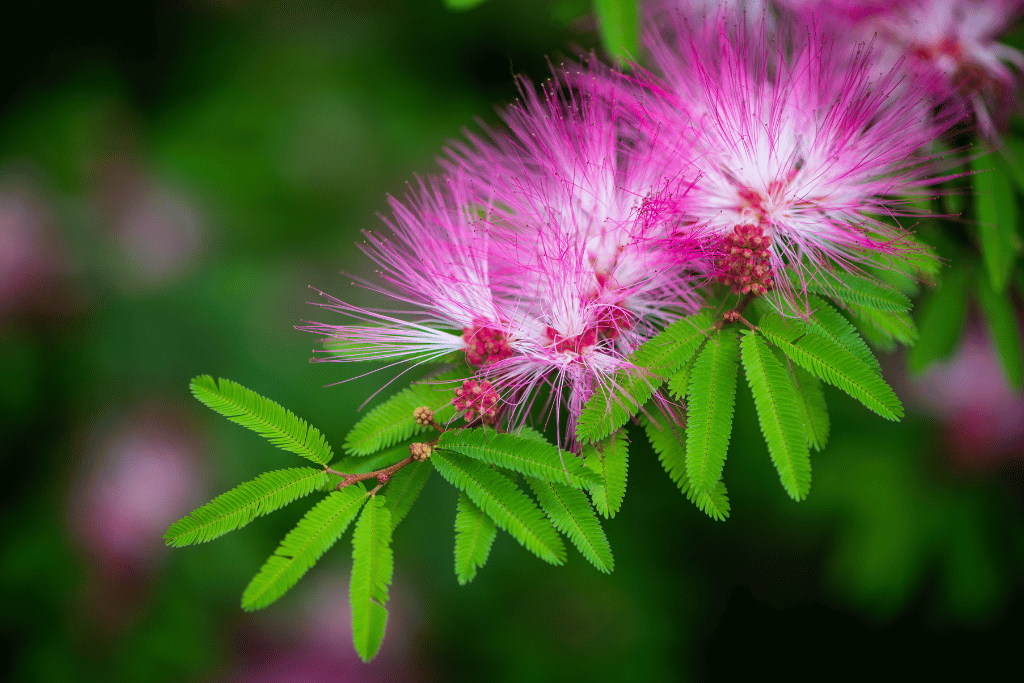
Native to Asia, Silk Tree is known for its feathery, fern-like foliage and fluffy pink flowers that resemble silk threads. The name “silk tree” alludes to the soft texture of the flowers and leaves. Albizia julibrissin is the botanical name of this famous tree, a deciduous tree with a unique appearance and colorful blooms.
The vibrant pink blossoms of the silk tree make it a standout in landscapes, adding a touch of exotic elegance to gardens and streetscapes. These showy flowers are particularly striking against the tree’s delicate, fern-like leaves. In addition to its visual appeal, silk tree also holds cultural significance in various parts of the world, often symbolizing femininity, beauty, and rebirth. Its ability to thrive in warm climates and enhance outdoor spaces with its unique beauty has contributed to its popularity among garden enthusiasts and urban planners.
23. Sun Star – Brilliant blooms of the summer sky
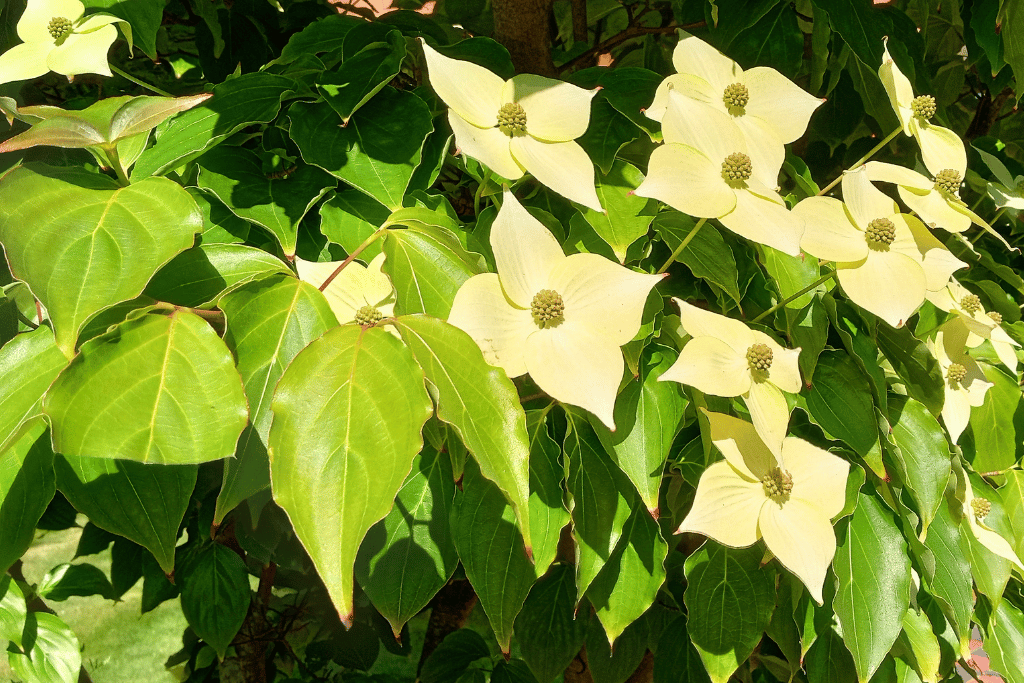
Sun Star, scientifically known as Ornithogalum dubium, is a flowering bulb plant that graces gardens with its radiant clusters of star-shaped flowers. These blossoms come in vibrant shades of orange and yellow, often resembling miniature suns. The name “Sun Star” aptly captures their bright and cheerful appearance.
Native to South Africa, Sun Stars are celebrated for their ability to thrive in warm and sunny conditions, adding a burst of color to garden beds and containers during the summer months. The striking contrast between their colorful petals and the surrounding green foliage enhances their visual impact. Symbolically, Sun Stars evoke feelings of warmth, vitality, and happiness, making them a popular choice for creating joyful and dynamic garden displays.
24. Strawberry Fields Gomphrena – Whimsical globes of pink
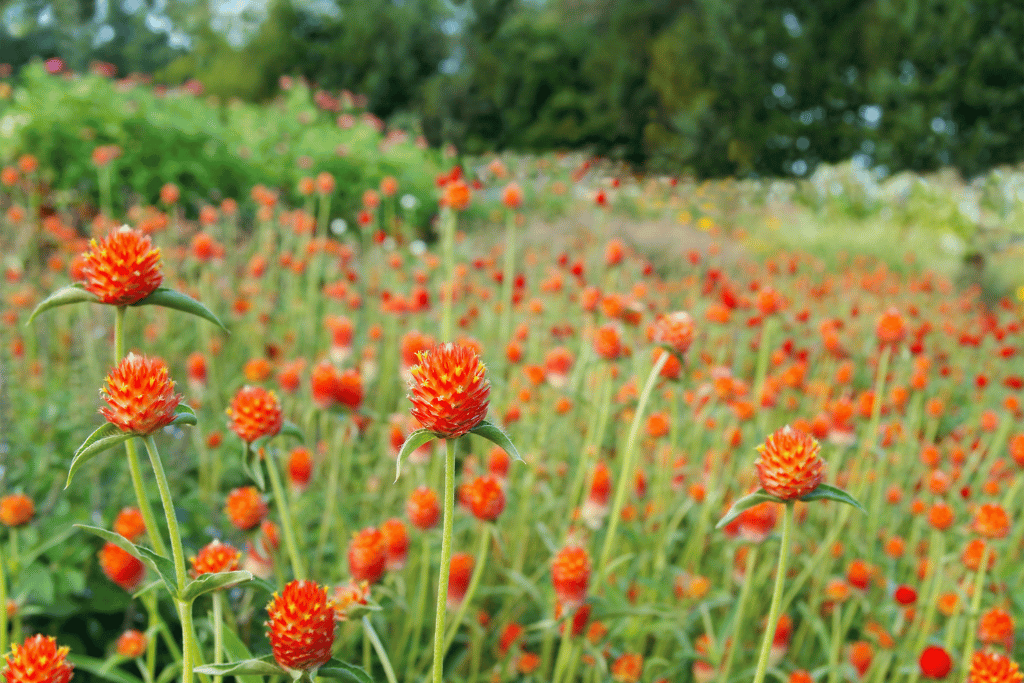
Strawberry Fields Gomphrena, blooms have a unique texture and form, creating a whimsical and playful effect in garden landscapes. The name “Strawberry Fields” reflects the vibrant and varied colors of the flowers. Its scientific name is Gomphrena haageana, a flowering plant that produces captivating globe-shaped flower clusters in shades of pink, orange, and red.
Native to Central and North America, Strawberry Fields Gomphrena is valued for its ability to attract pollinators like bees and butterflies. The long-lasting nature of the flower clusters makes them ideal for both fresh and dried flower arrangements. The plant’s vibrant and cheerful appearance adds a touch of joy to garden borders, beds, and wildflower meadows, creating a visual spectacle that changes with the shifting seasons.
25. Spiderwort – Graceful blossoms of the garden
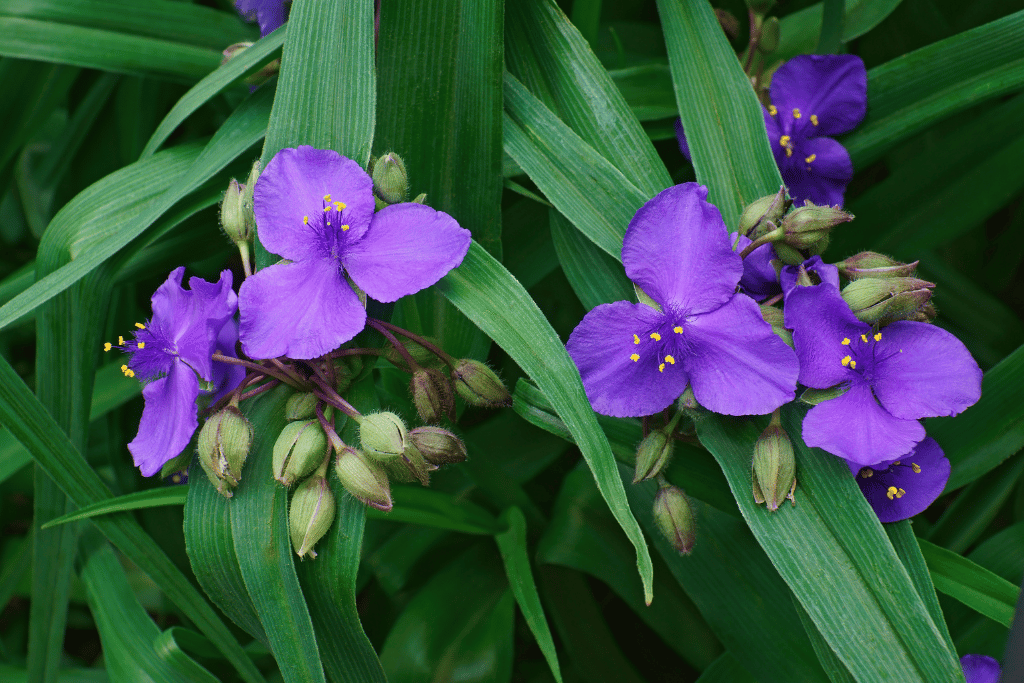
Spiderwort is associated with concepts of admiration, good fortune, and creativity. Its ability to thrive in various conditions and its charming blooms make it a welcome addition to both formal and informal garden settings. Spiderwort, scientifically called Tradescantia, is a flowering perennial plant known for its delicate and intricate blossoms. These flowers typically have three petals and come in shades of blue, purple, pink, or white. Spiderwort’s common name is inspired by its long, arching stems and unique reproductive structures.
Native to the Americas, spiderwort has become a popular choice for gardens due to its graceful appearance and ability to attract butterflies and hummingbirds. Its flowers open in the morning and close in the afternoon, creating a dynamic display that changes throughout the day.
26. Swamp Lily – Ephemeral elegance in wetlands
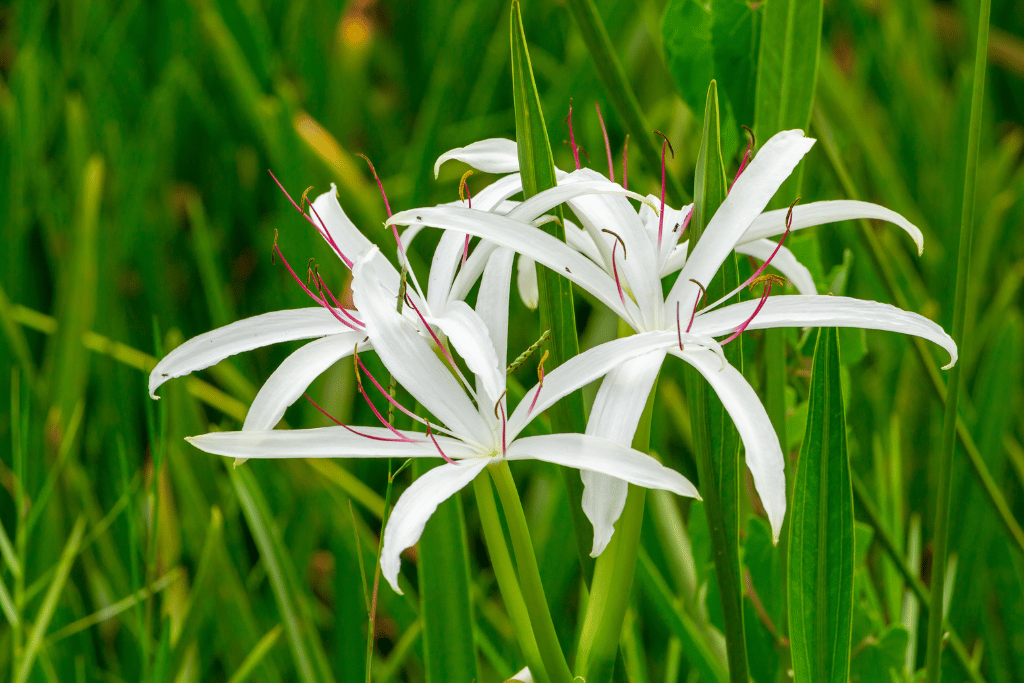
Native to North America, Swamp Lilies are valued for their ability to grow in challenging conditions and provide habitat for wildlife. Their blooms often emerge above the water’s surface, creating a serene and picturesque scene in wetland areas. Symbolically, Swamp Lilies represent purity, rebirth, and resilience, echoing their ability to thrive in environments that might seem inhospitable to other plants.
Swamp Lily, scientifically known as Crinum americanum, is a flowering plant that thrives in wetland habitats, such as marshes and swamps. These lilies produce clusters of fragrant, white flowers with a delicate appearance, adding a touch of elegance to waterlogged landscapes. The name “Swamp Lily” reflects its preference for moist environments.
27. Soapwort – Historical beauty with cleansing properties
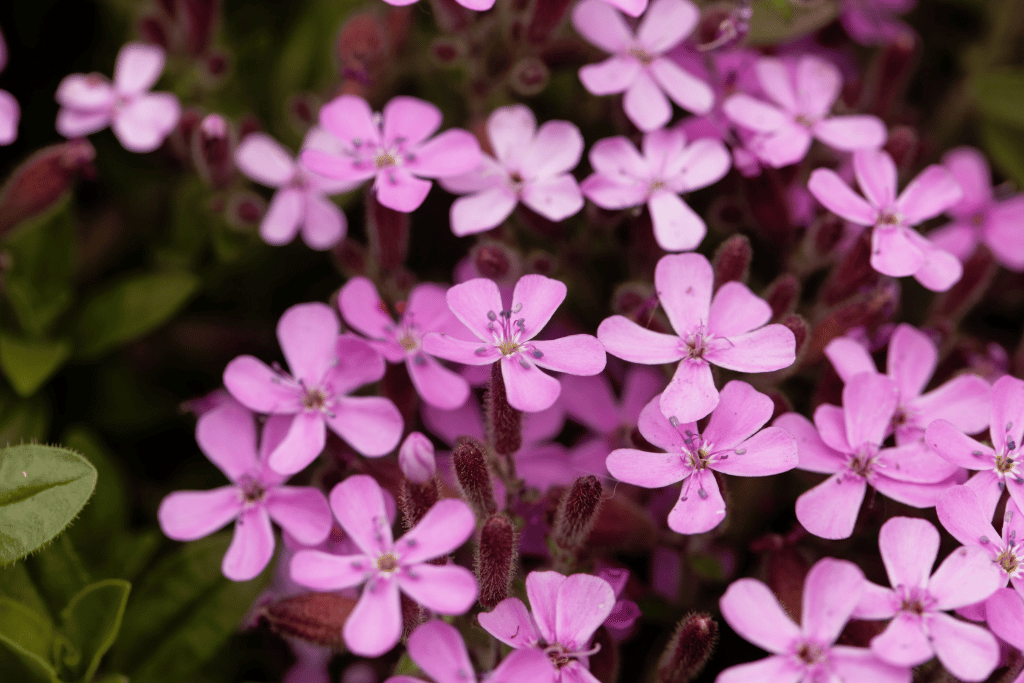
The name “Soapwort” originates from the plant’s ability to produce a natural soap-like lather when mixed with water. It’s native to Europe and Asia, soapwort is appreciated for its historical significance and dainty, fragrant blooms. The botanical name is Saponaria officinalis, representing a flowering plant with an extensive historical record of being valued for its cleansing characteristics. Beyond its practical application, soapwort also presents dainty gatherings of pink, white, or lavender blossoms.
It’s native to Europe and Asia, soapwort is appreciated for its historical significance and dainty, fragrant blooms. The plant’s flowers are often associated with love, honesty, and compassion. In addition to its ornamental value, soapwort’s traditional use as a natural cleaning agent has contributed to its appeal for those interested in sustainable and eco-friendly practices.
28. Stargazer Lily – Bold and aromatic blossoms
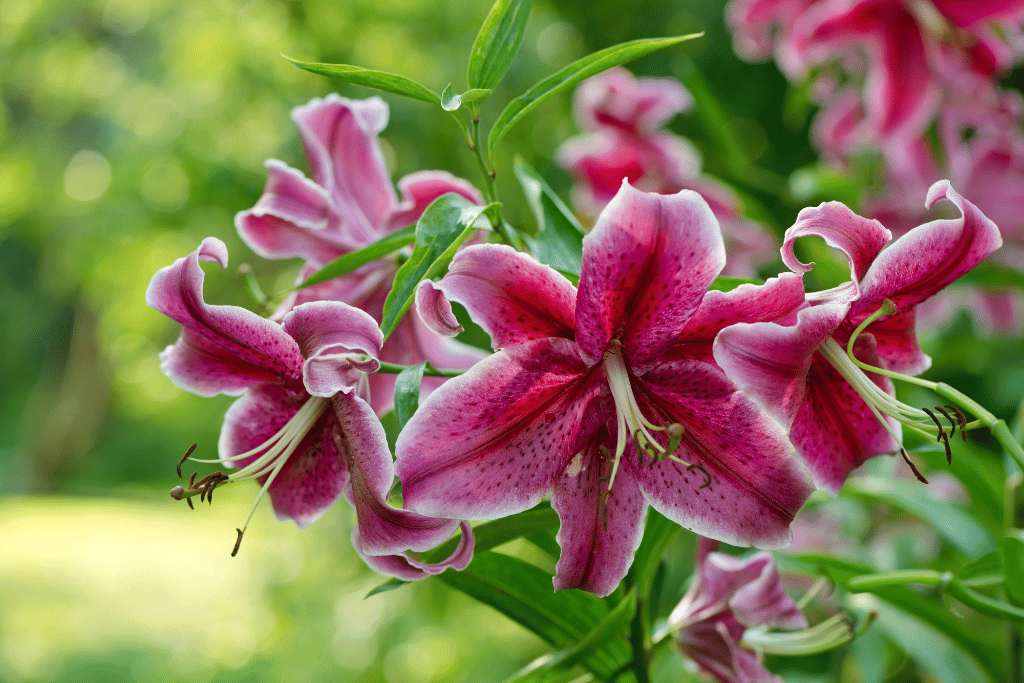
Originating from the late 20th century, Stargazer Lilies have quickly become a popular choice for cut flower arrangements, gardens, and special occasions. Their bold colors and intense fragrance make them a favorite among flower enthusiasts seeking to make a statement. Stargazer Lilies symbolize aspiration, passion, and admiration, making them a cherished gift for expressing strong emotions and celebrating significant moments.
Stargazer Lily, scientifically known as Lilium ‘Stargazer’, is a hybrid lily known for its dramatic appearance and powerful fragrance. These large and showy flowers feature vibrant pink or red petals adorned with distinctive white edges and freckles. The name “Stargazer” alludes to the upward-facing blooms that seem to gaze at the sky.
29. Sea Holly – Prickly elegance of coastal landscapes
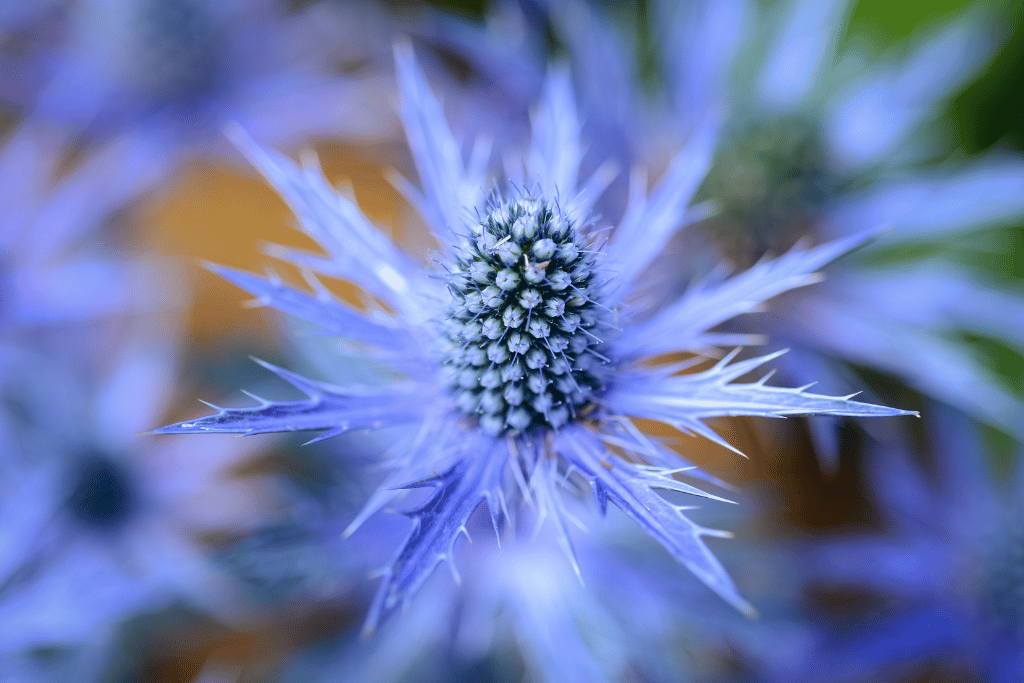
The name “Sea Holly” reflects the plant’s similarity to the unrelated true holly. Sea Holly, scientifically known as Eryngium, is a genus of flowering plants that thrive in coastal and dry habitats. These plants produce spherical flower heads surrounded by spiky, metallic-blue bracts that resemble the vibrant shades of the sea.
Sea Holly’s symbolism varies, often representing protection, enchantment, and a connection to maritime environments. Its prickly beauty and ability to flourish in challenging conditions make it a favored choice for xeriscaping and coastal gardening. Native to Europe and other regions, Sea Holly’s unique appearance adds texture and color to gardens and natural landscapes. The metallic-blue color of the bracts, often mistaken for petals, gives the plant a distinct and eye-catching appearance.
30. Sacred Lotus – Symbol of spirituality and purity

Sacred Lotus, aquatic perennial produces large, elegant flowers with layered petals that range in color from pink to white. The lotus holds deep symbolism in various religions, often representing spiritual enlightenment, purity, and rebirth.Nelumbo nucifera, identified by its scientific name, is an aquatic botanical recognized for its cultural importance and captivating aesthetic appeal.This
Native to Asia, the Sacred Lotus is revered in Hinduism, Buddhism, and other belief systems. Its ability to emerge from muddy waters to produce pristine blooms has made it a powerful symbol of transformation and resilience. Beyond its spiritual importance, the lotus also contributes to aquatic ecosystems by providing habitat and food for various wildlife. The Sacred Lotus’s combination of cultural significance and captivating appearance has solidified its place as a cherished and iconic flower.
31. Sagebrush – Aromatic symbol of the American West
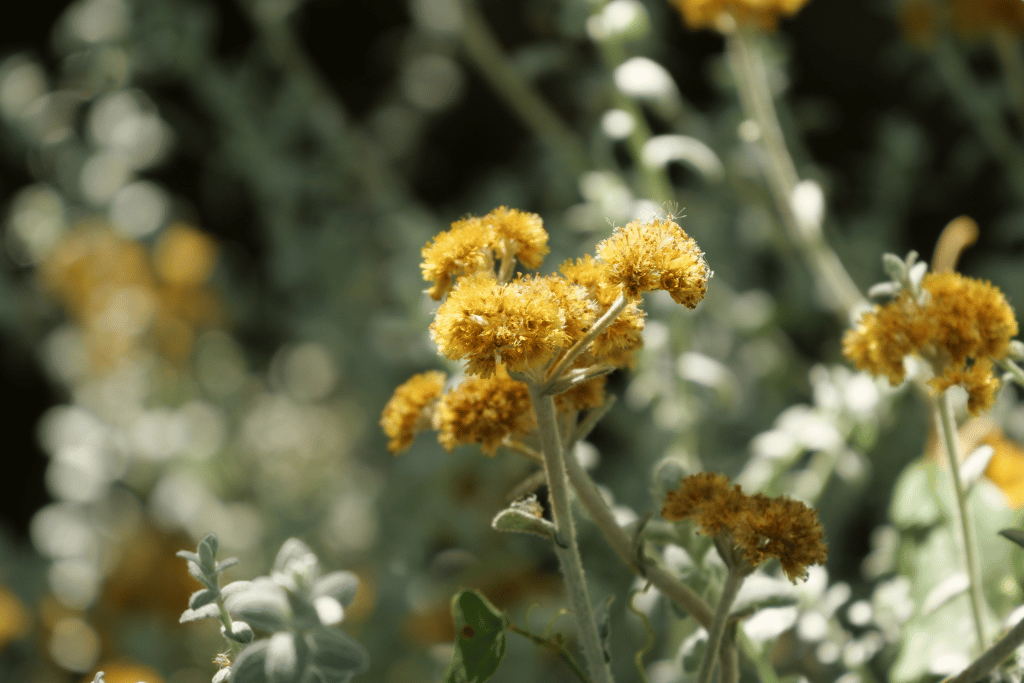
Sagebrush plays a crucial ecological role in its native habitats, providing shelter and sustenance for various wildlife, including birds and mammals. Sagebrush, scientifically known as Artemisia tridentata, is a group of aromatic shrubs native to the arid regions of North America, particularly the American West. While not traditionally known for showy flowers, sagebrush boasts silvery-gray foliage with a distinctive fragrance that permeates the air.
Its presence symbolizes adaptability and resilience, as these shrubs have managed to thrive in harsh and challenging environments. Additionally, its leaves have been used by Indigenous peoples for various purposes, such as medicinal and ceremonial applications. Sagebrush landscapes are often associated with the unique beauty of the American West, evoking images of wide-open spaces and rugged terrain.
32. Swamp Rosemallow – Graceful blooms of wetlands
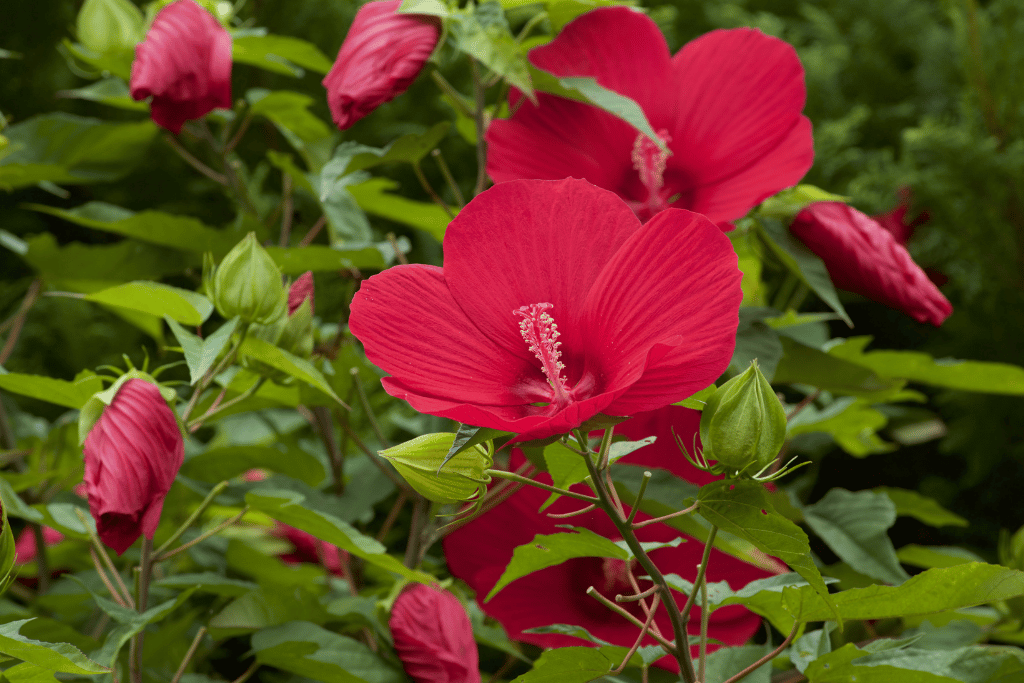
Swamp Rosemallow has cultural significance in various Indigenous traditions, often symbolizing grace, beauty, and resilience. Its ability to attract pollinators and contribute to wetland ecosystems makes it a valuable addition to natural landscapes, ensuring the vitality of water-dependent habitats. The name “Swamp Rosemallow” reflects its marsh-loving nature and the resemblance of its blooms to traditional roses.
Swamp Rosemallow, scientifically known as Hibiscus moscheutos, is a flowering perennial that thrives in wetland habitats, such as marshes and riverbanks. This plant produces large, showy flowers in shades of pink, white, or pale lavender. Native to North America, Swamp Rosemallow’s striking blooms provide a burst of color and elegance to waterlogged environments. Despite its delicate appearance, the plant’s resilience allows it to thrive in challenging conditions.
33. Star Jasmine – Fragrant climbers with starry blooms
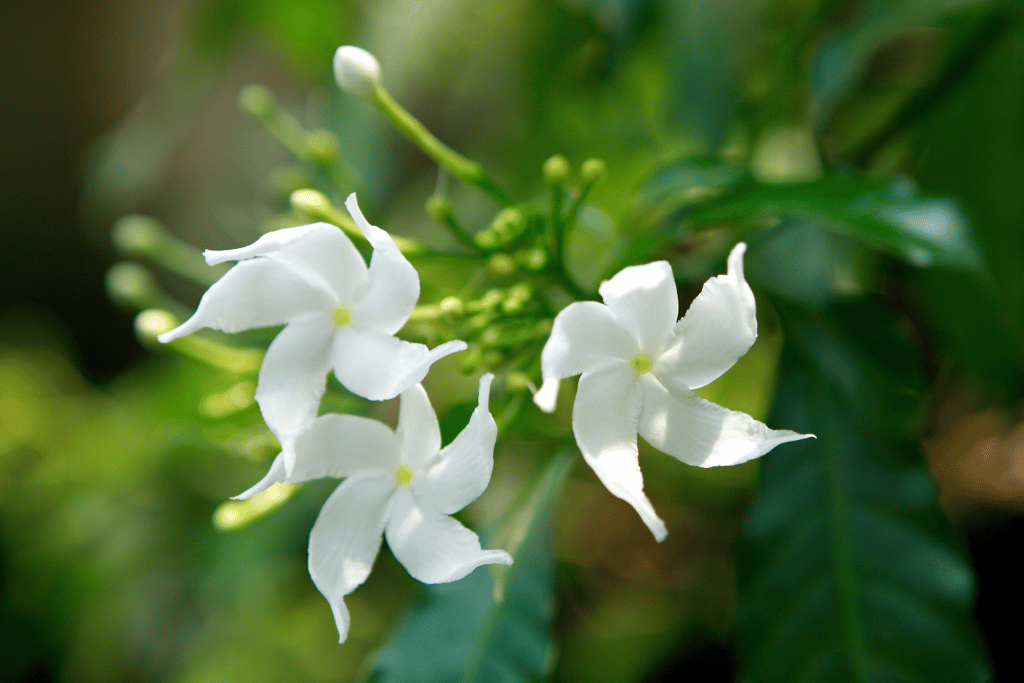
Star Jasmine is native to Southeast Asia, and this evergreen climber produces clusters of small, waxy flowers that emit a sweet and intoxicating fragrance, especially in the evenings. In scientific language, these showy blooms, known as Trachelospermum jasminoides, are a vine celebrated for its fragrant white blossoms that resemble stars.
Star Jasmine’s ability to adorn trellises, arbors, and fences with its glossy leaves and delicate blooms has made it a favorite for creating romantic and scented garden spaces. The fragrance of Star Jasmine evokes feelings of tranquility and relaxation, contributing to a calming atmosphere. The plant’s symbolism often centers around love, happiness, and enduring affection. Its versatility, elegant appearance, and captivating scent have turned Star Jasmine into a sought-after addition to gardens and outdoor living areas.
34. Sturt’s Desert Pea – Dramatic blooms of arid landscapes
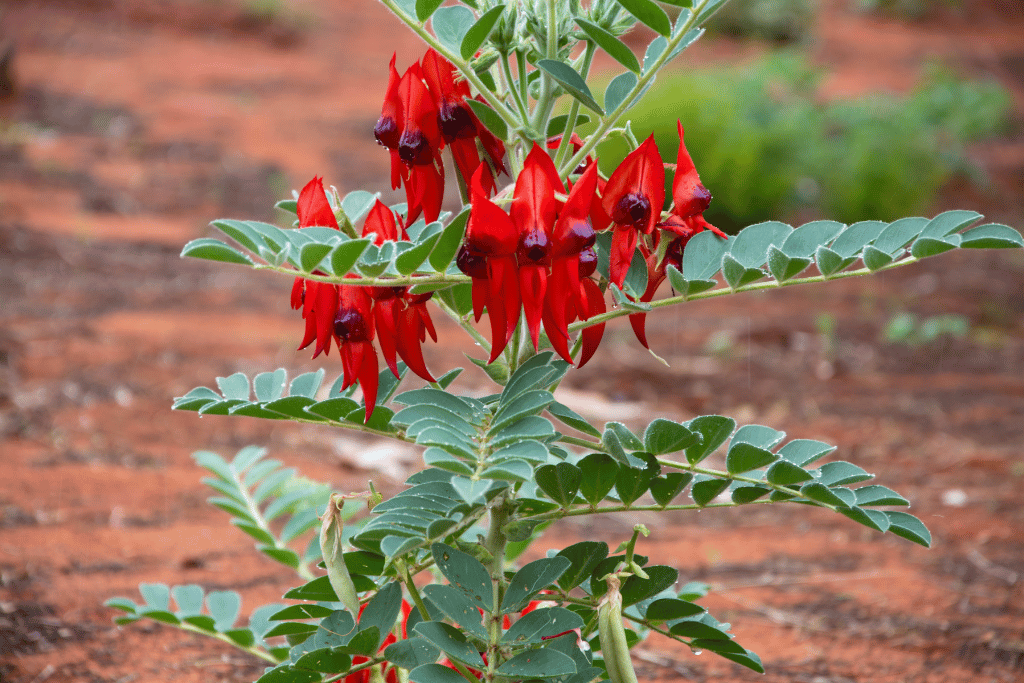
Sturt’s Desert Pea, scientifically known as Swainsona formosa, is a flowering plant that thrives in arid and desert environments. This unique plant produces striking blood-red, pea-like flowers with a distinctive black center. The flower’s appearance, contrasting against the harsh desert backdrop, creates a dramatic and visually arresting sight.
Native to Australia, Sturt’s Desert Pea has cultural significance among Indigenous peoples, often symbolizing themes of blood, sacrifice, and beauty. The plant’s resilience in the face of challenging conditions adds to its symbolism of endurance and vitality. Sturt’s Desert Pea has become an iconic floral emblem of Australia’s arid regions, celebrated for its unique beauty and ability to thrive in landscapes that may seem inhospitable to other vegetation.
35. Spanish Dagger – Majestic architectural presence

The name “Spanish Dagger” alludes to the plant’s sharp, pointed foliage. These Aloe like plants, scientifically known as Yucca gloriosa, is a flowering plants known for its dramatic architectural form and hardiness. This yucca species produces tall spikes adorned with clusters of creamy white flowers, contrasting its sharp, sword-like leaves.
Symbolically, Spanish Dagger represents strength, protection, and the ability to overcome adversity. The plant’s strong and majestic presence makes it a sought-after addition to landscapes seeking a touch of bold elegance. Native to the southeastern United States, Spanish Dagger is often used as a striking focal point in xeriscapes, desert gardens, and coastal landscapes. Its ability to thrive in challenging conditions, including poor soil and drought, adds to its appeal for low-maintenance gardening.
36. Snake’s Head Fritillary – Whimsical and intricately patterned
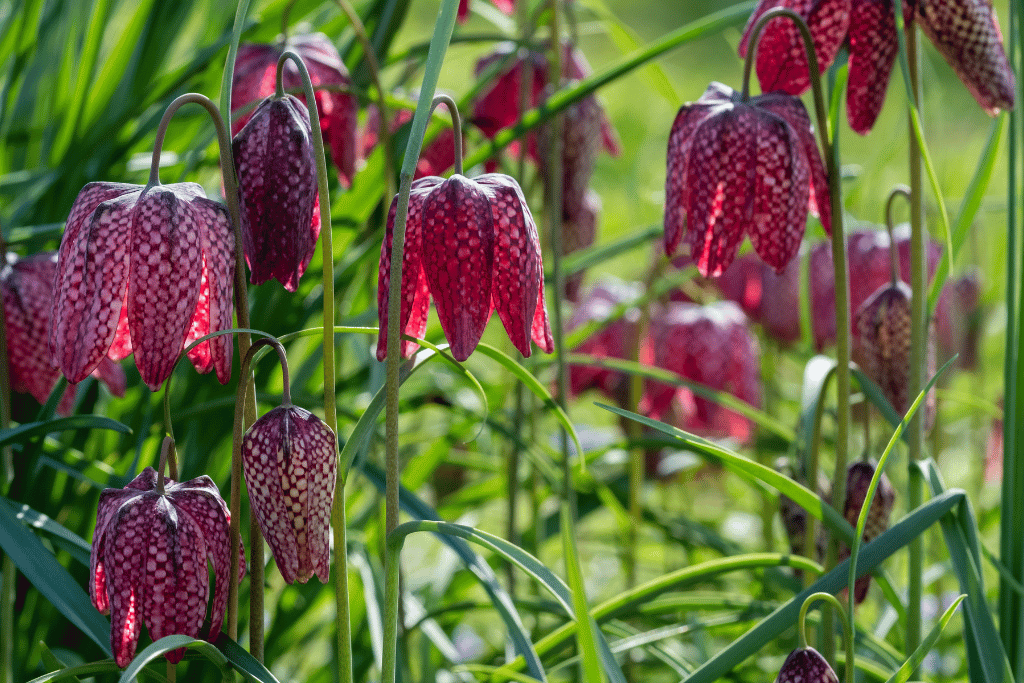
Snake’s Head Fritillary, scientifically known as Fritillaria meleagris, is a charming flowering bulb known for its unique and intricately patterned blooms. These flowers, which resemble snakeskin or chequered patterns, come in a variety of colors, including shades of purple, pink, and white. Snake’s Head Fritillaries offer a playful and magical touch to spring landscapes, capturing the essence of nature’s creativity and captivating beauty.
The name “Snake’s Head Fritillary” derives from the distinctive markings on the petals. Native to Europe, Snake’s Head Fritillary is a cherished springtime sight in meadows, gardens, and damp grasslands. The whimsical appearance of the flowers evokes a sense of wonder and delight. Beyond their visual appeal, these fritillaries hold historical significance and cultural symbolism. They are often associated with various legends and stories, adding to their allure.



